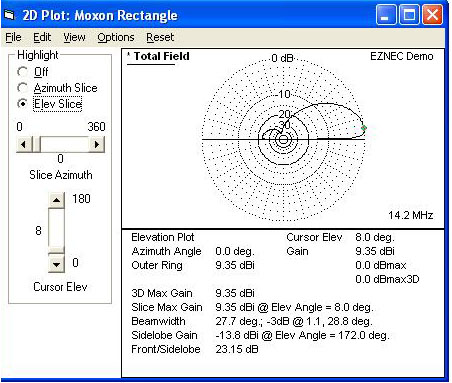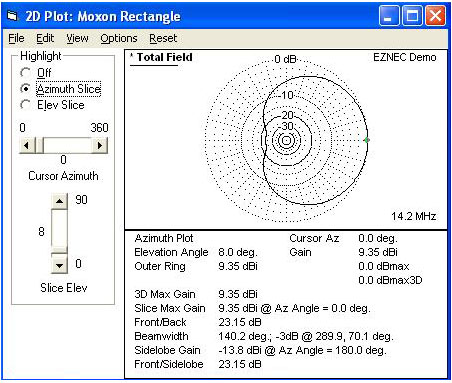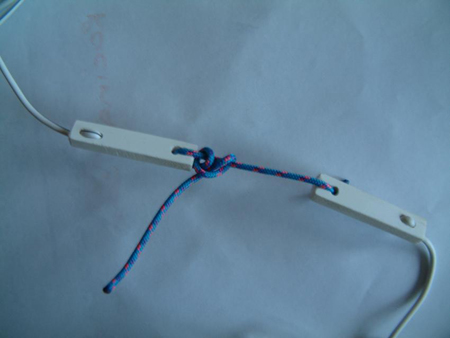M3KXZ'S QRP Beach Vertical 20m Moxon at Seaford Bay, England
1/3/06:
All my working is HF QRP SSB and I usually rely on my 8 metre fishing
poles, trusty homebrew non-resonant 44ft doublet antennas (one at home and
one for portable) and also a 10 metre tall homebrew vertical at home.
I only live 2 miles from the sea and thought it would be fun to operate
from the beach at Rottingdean. I've spent a couple of days down there with
my inverted V doublet but this doesn't benefit from salt water in the same
way as a vertical. I wanted something directional so I could avoid wasting
precious RF on the cliffs and therefore considered a vertical dipole with a
parasitic reflector. The thing is, my main band of interest for this
project is 20 metres, and my fishing poles are too short for 20 metre
dipoles. So then I thought about using a linear loaded dipoles on the
fishing poles, but the modeled gain and F/B ratios were poor.
Anyway, thanks to Adrian (EA5/G0KOM, ZC4MK, VP8COI)
on the G-QRP list who first mentioned the word "Moxon" and
referred me to your website, I noticed that all of the previous Moxon
projects seem to be for horizontal and vertical rectangles mounted quite a
good distance above the ground, and were displaying excellent F/B ratios. I
can't mount mine high seeing as I only have two 8 metre fishing poles and
some home-made ground supports, and I also wanted mine vertical to gain the
most benefit from the sea.
I have now come up with a design comprising a 20 metre Moxon rectangle,
mounted vertically with the base at a height of between 0.5 and 1 metre
above salt water. The modeled gain is in the order of 10dBi with a F/B
ratio of over 20dB. This is higher than anything achieved with the dipole
and parasitic reflector, and completely slaughters all of the other designs
I had looked at for a "beach vertical array".
Tomorrow (Wed 4th Jan) at 1400 UTC is testing time. If things go to plan
then I'll follow this up with some comparative testing against some known
quantity - maybe a Buddipole.
Today indicated that total setting up time is about 10 minutes, and both
the poles and the ground supports can be carried in one neat bundle of 1.5
metres long.
1/5/06:
I didn't get a chance to test yesterday in the end due to
poor weather. No rain today though so I should have something to report
this afternoon.
I don't know if you use EZNEC at all, but in case you do I've attached the
EZ files for the designs for 20, 17, 15 and 12 metre vertical Moxons, all
with base height 1 metre above the beach. Please ignore the warning about
segment length - I was using the demo version but validated the designs
using MMANA as well. The downside of MMANA is that you can't account for
insulation on the wire.
(the links download the eznec files)

Initial dimensions came from the Moxgen program for the 20 metre Moxon in
free space. I then shifted this into EZNEC so I could optimise the model
for a 20m vertical Moxon rectangle constructed from at low height above the
beach, and constructed from 1.3mm dia copper wire with 0.85mm PVC
insulation (heavy duty speaker wire). I know there are losses associated
with the PVC insulation but the wire is inexpensive, robust and very
flexible which is ideal for portable operation. By modeling with this wire
in Eznec I was able to account for the drop in resonant frequency resulting
from the dielectric constant of the PVC insulation.

I then ran the same dimensions in MMANA accounting for the difference in
resonant frequency to validate the EZNEC designs. The reasoning behind this
was that the MMANA program is not restricted in the number of segments the
wires can be broken down into.
All dimensions in the attached EZ files on slightly on the long side to
allow for some trimming in-situ. I should also be able to fine tune by
raising or lowering the antenna above the salt water ground. Between 0 and
1 metre height there is quite a profound effect on the resonant frequency,
and the supports I have made allow me to easily alter the height in
increments of 10cm.
If this doesn't work this afternoon I'll have mucho egg on my face - I've
been happy with results from EZNEC in the past but this is my first go at
something for the beach!
1/6/06:
I have good news to report. The antenna worked extremely well -
Running SSB on 20 metres and just 2.5 Watts to save batteries, my signal
reports from the beach on south coast of UK to Serbia and Montenegro
(YU50NR), Lithuania (LY1TR) and Southern Spain (EA7/SM4RKS) were all 59. I
know condx have been good today but these are a couple of S points higher
than usual, and running half my usual power. Not exactly mega-DX but this
was my first outing with it. The guy in Lithuania (LY1TR) I have spoken to
a couple of times before. He was running 600 Watts and was amazed at how
strong my 2.5 Watts were.
Wanted to reach US today but there was a lot of crowding on the band and
plenty of rag-chewing. I didn't really have the patience to persevere, in
part due to the cold and having to get back to collect kids from school.
Received signals were exceptional with little noise.
The FT817 has a SWR display built in. When I first set the antenna up, the
coax cable was hanging down the side of the driven element, and a couple of
bars of the SWR display were lit up. I thought I was in for a bit of
trimming. But I moved the coax away from the driven element, so it was
hanging at about 45 degrees, and the SWR dropped right down. No trimming
was necessary and no tuner was used, which is a bonus.
Stones on the beach were a bit of a problem - I busted one of my fishing
pole supports trying too hard to twist it into the ground. Never mind -
only a few pennies for another.
Construction details:

Driven element - 7.26 metre vertical section, 1.15 metre horizontal sections
Reflector - 7.26 metre vertical and 1.42 metre horizontal
Spacing between driven element and reflector ends - 0.11 metres
Height of base above ground - variable up to 1.0 metres.
I wanted the whole lot to be "marine-ized" so I've sealed the coax end on the centre part with Araldite (epoxy resin) and used stainless steel hardware. The distance between the ends of the driven element and reflector are easily altered using the rigging rope. In practice, the optimised model showed 11cm to be the best distance for this project, I tied the rope off to give 11 cm between ends and didn't have to do anything else. The whole lot is then secured to the fibreglass fishing poles using "O" rings of various size. I just leave these floating on the antenna wire when I roll it all up.
Two O rings around the centre part of the driven element keep that secured
well to the fishing pole.

I finally have some more pictures for you, taken
today while operating QRP from the beach on the east side of Seaford Bay,
about 8 miles east of Brighton on the south coast of England.
I had the Moxon set up directed West-South-West (ish) and had some
fantastic strong QSOs into the US. All operators were extremely surprised
at the strength of the signal for 5 W. My sigs into the US were 2 s points
higher than when I've been operating either with the omni-directional
vertical or with the inverted V doublet. Received signals were also much
stronger from the US. One massive benefit I observed was that the
directionality and virtually eliminated the s9++ QRO stations from Italy
and Germany that often make it difficult working anything else.
I hope the pictures give some idea of how I set the Moxon up. The distance in a straight line from the driven element to the actual sea was about 30 metres. But the shingle down here is saturated with salt water and I didn't see the point in going right down to the water and getting too wet! Again, there was an instant match with the 50 Ohm coax and no trimming needed. Set up took a few minutes longer today though as I'd forgotten to clear the sand out of my telescopic fishing poles last time. This meant I had to spend a while "un jamming" them. Still, it was well worthwhile.
The intention is to get back down to the beach some time next week, when
hopefully it's not quite so cold and windy, to test the Moxon alongside
something else.
All the best
Pete Millis M3KXZ G-QRP 11767
Brighton UK